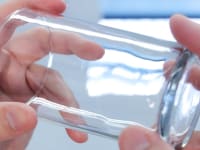Here’s how we test vacuums in the Reviewed test labs
From to uprights to handhelds—here's how we do it
 Credit:
Reviewed / Timothy Renzi
Credit:
Reviewed / Timothy Renzi
Recommendations are independently chosen by Reviewed's editors. Purchases made through the links below may earn us and our publishing partners a commission.
Here at the Reviewed test labs, it seems like we bring in endless shipments of all kinds of vacuums every year. We estimate we’ve spent over 2,000 hours testing vacuums since we started in 2011.
From a variety of popular brands—Dyson, Hoover, Shark, Miele, Tineco, Bissell, and Oreck, among them—to the most commonly used styles—upright vacuums, cordless vacuums, handheld vacuums, stick vacuums, canister vacuums, wet-dry vacuums, and robot vacuums—our experience knows no bounds.
It is Reviewed’s mission to help you buy the best stuff and get the most out of what you already own. Tests are developed by our lab staff, under the direction of Reviewed’s chief scientist, David Ellerby, Ph.D.
When a vacuum comes into our testing labs, we put it through several science-based tests to determine how well it cleans. We also test its ease of use and see if its features live up to manufacturer claims.
We look at how a vacuum performs against dirt and dust on different surfaces, floor types, and carpet piles, its suction power, whether it can tackle pet hair, its ability to deep clean carpet, its battery run time, and what kind of brush attachments and crevice tools it includes to enhance cleaning capabilities, among other things.
Here is a quick overview of how we test vacuums in the Reviewed lab and a glimpse into the scientific rationale behind what we do.
Our testing facility: The Reviewed Lab
Want to know what makes Reviewed stand apart from competitive product review sites like Wirecutter, Cnet, The Spruce, and Better Homes & Gardens? We go beyond user experience, travel farther than a home improvement store floor. We bring large appliances like vacuums into our Cambridge, Mass., testing facility, and we run them through a rigorous testing process based in science and compliant with industry standards. Our own chief scientist and our lab technicians gather data and use it to form assessments, which result in our findings. This process puts us in the ranks of product testing legends, Consumer Reports and Good Housekeeping.
When it comes to vacuums specifically, we test in a controlled environment that is set to 72°F, 50% relative humidity, and a separate HVAC unit that provides mild positive pressure. We also base some of our tests on industry standards set by ASTM, specifically the guidelines around making our testing dirt.
Dirt test: How many grams can it suck up?

We make our own dirt for testing.
Here at Reviewed, we make our dirt from a mixture that complies with ASTM International standards and contains grain sizes ranging from 106 micrometers to 600 micrometers.
This mixture allows us to cover the entire range of common household dirt. Anything smaller and the particulates stay in the air, placing it in the providence of your air purifier.
We apply the dirt to each testing surface, impact it with a heavy roller to simulate foot traffic, and weigh vacuums before and after to see how much they pick up.
However, vacuums need to be able to pick up more than dirt. To simulate foodstuffs, we use uncooked rice and macaroni. Rice, because of its rounded exterior, is ideal for testing the vacuum’s ability to pick up small debris without pushing it around.
Macaroni is great because it can break apart under pressure. If a vacuum can pick up macaroni, it has the right balance of suction and brush spin—if a brush spins too fast, it often launches the macaroni across the room.
The final cleaning challenge is pet hair. We source pet hair from Bernese mountain dogs and tabby cats. Not only do we check if a vacuum can pick it up, but also to see if it clogs the hose or winds around the brush roll.
Surface test: Hardwood floors, area rugs, and other floor types

We use a variety of surfaces to test our vacuum cleaners.
We test vacuums in a room with its HVAC system. This not only helps keep the temperature and humidity stable but also creates positive pressure—helping to keep out unwanted particles.
Since dirt adheres differently, we test a vacuum’s suction and cleaning power on different surfaces, including medium-pile and high-pile carpet, linoleum, and hardwood flooring.
Sometimes, brands design a vacuum to specialize in cleaning specific surfaces, while other vacuums are more versatile.
Reach test: Ability to clean under furniture and awkward spaces

We create our own testing systems, like this one that mimics furniture height to test a vacuum cleaners' reach.
Vacuums also need to be able to reach under furniture to clean. We simulate this with a sort of limbo device—a wooden bar suspended at different heights—that measures how far a vacuum can reach given a set clearance.
In some instances, we also test the vacuum on actual furniture. For example, we were concerned that the Dyson Animal 2 would not be able to clean under furniture. We tested that hypothesis by using the Animal 2 around normal couches and chairs.
Practicality test: Ease of use for most people

How the vacuum feels while it's being used is another important factor.
While cleaning ability tops our list of what makes a vacuum a good vacuum, ease of use is also incredibly important. If your vacuum is too heavy or doesn’t have the right attachments, it’s really of no use to you.
Lastly, we try to deduce if a vacuum will work well in most homes and for most people. We weigh it, measure how loud it gets, and calculate how much strength is required to pull it across the carpet.


